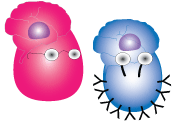
Antibodies – linking innate and adaptive immunity
The Fc part of the antibody can not only bind to FcR. The Fc end of IgG and IgM are capable of also binding and activating complement as shown in the innate module. In the innate module we saw how activation of the complement system resulted in the lysis of antibody tagged cells, but the C3b protein fragment that is generated following complement activation can also act as a tag for clearance of the antigen-antibody complex via phagocytosis. This is because red blood cells and macrophages have receptors for C3b so can bind and ingest these antigen:antibody complexes. Red blood cells ferry these antigens and infectious agents to the liver or spleen where they are unloaded and destroyed by waiting macrophages. Notice how receptors on the surface of the body's assassins and garbage disposal units have evolved to bind the Fc portion of the key molecules that coat pathogens; antibodies tag them and phagocytic cells bag them. It is not only the phagocytic cells that have evolved to take advantage of the antigen specificity that the antibodies provide. Over the last few pages we have mentioned how complement and NK cells kill antibody coated cells and mast cells degranulate after FcεRI cross-linking. We witness the sophisticated adaptive defences and primitive innate defences working together in perfect harmony!